

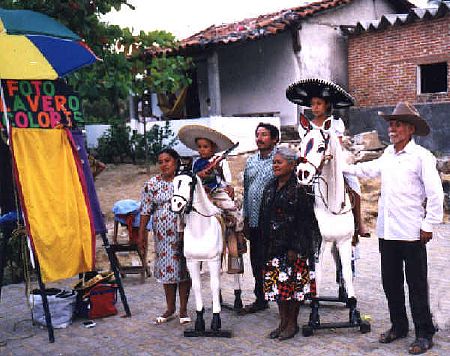
Many of the names are familiar to visitors because literally thousands of streets, neighborhoods towns and even states are named for these national heroes: Hidalgo, Morelos, Guerrero, Matamoros, Allende, Aldama to name a few.
Independence Day is celebrated on Sept. 16 with parades and civic ceremonies in every village, town and city in Mexico.
The preceding night (Sept. 15) the Ceremony of the Cry for Independence takes place. It marks el Grito de Dolores (the Cry of Dolores), Father Miguel Hidalgo's impassioned call for a popular uprising that launched the movement for independence from Spain in 1810.
This was a time when revolutionary upheaval and radical change swept through both the Old World and the New. The exciting new ideas of the Enlightenment inspired both the American War of Independence and the French Revolution.
Rationalism, the pursuit of science and the arts, the promotion of religious toleration, and a desire for government free of tyranny; it was pretty heady stuff.
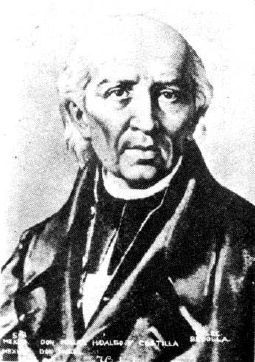 Hidalgo |
 Morelos |
Bridling under the reactionary and repressive political, economic and cultural control of Spain, more and more they defined themselves as Americans.
In 1808 Napoleon invaded Spain and, forcing the abdication of King Ferdinand VII, placed his brother on the Spanish throne.
This was met with resistance in Spain and political confusion in the colonies and it offered the independentistas the opportunity to meet and organize under the political context of expressing opposition to an illegitimate king, rather than to Spanish rule.
In 1810 the wife of the alderman of the town of Queretaro, doña Josefa Ortiz de Dominguez, along with Ignacio Maria de Allende, Juan Aldama, Mariano Abasolo among others planned an uprising for that October.
The parish priest of the town of Dolores, Miguel Hidalgo y Costilla, a brilliant academic and fervent campaigner for social justice, was invited to join the group. Royalist authorities got wind of the plot, however, so it was decided to move immediately and on the night of Sep. 15, word was sent to Father Hidalgo.
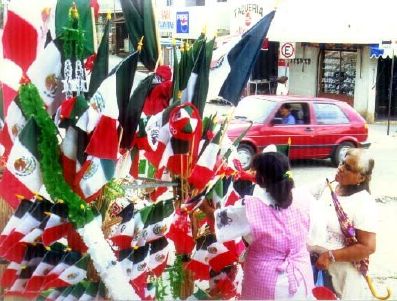 At dawn the next day, as people arrived from the surrounding areas for early mass, Hidalgo issued
his call to take up arms against tyranny and the war for Mexican liberation began.
At dawn the next day, as people arrived from the surrounding areas for early mass, Hidalgo issued
his call to take up arms against tyranny and the war for Mexican liberation began.
That day his forces, poorly armed, untrained and undisciplined, marched to Atotonilco and seized the standard of the Virgin of Guadalupe and made it the flag of the insurgent forces.
A series of rapid victories followed, but inexplicably the rebels did not press their advantage and march on the poorly-defended capital. Royalist forces were allowed to regroup and in the following months the original conspirators were killed in battle or captured and executed. José María Morelos fought on until his capture and execution in 1815 and the struggle was kept alive by small guerrilla groups, most notably Vicente Guerrero's in the south and Guadalupe Victoriano's in Veracruz.
It would be 11 years and 11 days after Hidalgo's Grito, Sept. 27, 1821, before the independence forces entered Mexico City in triumph to finally proclaim Mexico free of Spanish rule.
The Heroic Children of Chapultepec
The early decades of independence were troubled times for the new nation. The war had devastated
the economy and political stability made effective government impossible.
There were also threats from abroad. Spain refused to accept the loss of another colony and blockaded the country. France and the United States pressured for compensation for losses suffered during the civil upheavals, payments the bankrupt young republic was unable to make.
In what became known as the "War of the Cakes", Guerra de los Pasteles, the French seized Veracruz and forced the government to sign a treaty paying indemnification, including 60,000 pesos for a baker who had not been paid for cakes consumed by some soldiers.
Then it was the turn of the aggressively expansionist United States. With an ineffectual central government and an army poorly armed and with unbelievably inept leadership (Does the name Antonio López de Santa Ana ring a bell?), Mexico was powerless to prevent the annexation of Texas and then the invasion by U.S. forces lead by Gen. Winfield Scott.
But the defending Mexican forces did not lack courage. In 1847, in the capital, it was the cadets at the military school at Chapultepec who offered their lives in last ditch defense against the invaders.
Sun 2
Full Moon in Pisces at 4:44 p.m.
Wed 5
Election of "La America"
This event is to select the young woman who will represent Puerto during this month's events
celebrating the 191st anniversary of the launching of Mexico's struggle for Independence.
It's not a beauty contest: participants must be students who can demonstrate a knowledge of
Mexican history and be able to sing the national anthem. No mean feat.
6 p.m. Events Palapa at the Town Hall Esplanade
Thu 6 - Sat 8
Fiesta of the Birth of the Holy Virgin
A traditional saint's day fiesta activities will be held in many communities, most named Sta.
María, including Santa María Colotepec. These include the convite and calenda,
parades led by brass bands and huge papier mâché puppets through the streets of town
inviting everyone to participate in the festivities. The calenda takes place at night and includes
faroles, candle-lit paper globes.
Also common to these fiestas on the coast are the castillo fireworks display (Sept. 7),
rodeos, cockfights and dances.
Thu 13
Commemoration of the Heroic Children of Chapultepec
The martyrs of the defense of Mexico City against the invading U.S. juggernaut, young cadets
from the military academy in Chapultepec Castle - itself a powerful symbol of national identity -
are remembered on this day, the 154th anniversary of their deaths. (More details above)
A flag-raising ceremony takes place at 7 a.m. and a civic ceremony eulogizing the national
heroes begins at 9 a.m. An honor guard comprised of students from various local schools and
colleges holds vigil throughout the day at the monument to the Heroic Children located in the Town
Hall Plaza
Sat 15
Ceremony of the Cry for Independence
Mexico's independence movement began with the call to take up arms against Spanish rule by
Miguel Hidalgo y Costilla, the parish priest in the town of Dolores.
On this night before Independence Day, people gather at the local government building to watch
music and dance performances, listen to speeches and the traditional ceremony remembering the Cry of
Dolores, el Grito de Dolores.
The Program:
8:30 p.m. Social and Cultural Presentation, Town Hall Esplanade
9:30 p.m. "La America" (See Wed 5) makes her way through the main
streets of town to the Town Hall Esplanade
10:30 p.m. Grito Ceremony
11 p.m. Dance with Live Band Town Hall Esplanade
 Sun 16
Sun 16
Independence Day
191st anniversary of the birth of the movement for independence from Spain
8 a.m. Civic Ceremony Juárez Sports Stadium
8:30 a.m. Parade. The army, civic groups and every school and college in town participate.
The parade marches down Av. Oaxaca to Hidalgo street, then over to the Town Hall.
Mon 17
New Moon in Virgo at 5:28 a.m.
Tue 18 - Sun 23
3rd annual Puerto Escondido "Central Surf" Professional Longboard Invitational
The huge summer surf and traditional long board (9-foot minimum) make for an awesomely
challenging tournament for the world's best professional longboarders. (See below for more)
September 22
Autumn Begins at 6:04 p.m.
Mon 24 - Tue 25
Women's Professional Longboard Tournament
An addition to the Longboard contest this year, and the first ever women's pro event in Puerto.
Zicatela Point
Thu 27 - Sun 29
Fiesta of Saint Michael
The usual complement of parades, fireworks, dancing and bull-riding events. Puerto's colonia
San Miguel
Sun 29
End of Daylight Savings Time
There has been a great deal of opposition to DST in Mexico, so the government of Pres. Vincente
Fox came up with a compromise: Daylight Savings will began officially in May (one month later than
in the U.S.) and will end one month earlier (today, rather than the last Sunday in Oct.) Clocks
get turned BACK one hour (2 a.m. becomes 1 a.m.)
Radio, Radio
Sunday 8 p.m. to 10 p.m.
Chiles y Chocolates, a bilingual radio
program hosted by "Lucy Sonido", actually Canadian musicologist Helena Szutska, an eclectic mix of
music from around the world.
Wednesday 9 p.m.
La Luciernaga (Firefly)
Lucy's midweek, commercial-free hour of free-flowing music. Radio Esmeralda,
94.1 FM.
 All surf boards were
longboards when the sport was born; the Hawaiians used long and extremely heavy
slabs of tropical hardwood when they invented surf riding.
All surf boards were
longboards when the sport was born; the Hawaiians used long and extremely heavy
slabs of tropical hardwood when they invented surf riding.
The development of polyurethane foams and epoxy resins after World War Two produced more buoyant materials for surfboards and a single wide base fin was added to the back and the modern longboard was born.
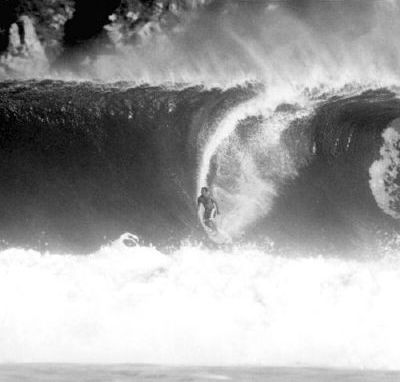
|
In the late sixties and early 70s the prospering sport of surfing underwent what is now referred to as the Short Board Revolution. New designs and materials reduced the average 9 or 10-foot boards down to 6 and 7 feet in length.
The primary difference between the two is that the rider moves up and down the board to control the longboard s movement, whereas the shortboard is maneuvered by shifting your weight while standing in the same spot on the board, much like riding a skateboard.
Shortboards are faster and more maneuverable; Longboards are best suited to small waves. You'll often see riders standing right on the nose of the board crusing a gently wave into shore.
But this laid back technique isn't what you can expect to see this month with the return of Puerto Escondido's "Central Surf" Longboard Invitational (Sept. 18 to 23).
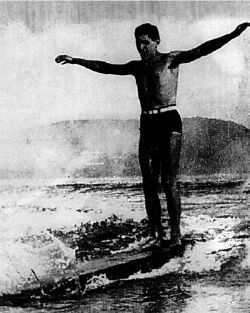
|
The brain child of Central Surf's Angel Salinas who has represented Mexico in numerous international longboard meets. The best longboard surfers in the world will be challenged to the limit of the sport by the capriciousness of the Zicatela s Summer surf.
Pros from Hawaii, Australia, USA, Japan, France, Tahiti, Brazil and Mexico have accepted the challenge of the third running of this tube-riding contest. Surfers will be judged on how well they maneuver their big boards (they must be at least 9-feet) through the famous pipeline.
The ideal conditions at this level of competition, say Angel Salinas, are waves of 7 to 9 feet. But September on Puerto Escondido's Zicatela Beach could provide swells far more formidable. 35-feet swells for the final of 1999 inaugural forced judges to call a tie for Kanoa Dahlin (Hawaii) and Beau Young (Australia)
Last year Darren Ledingham (USA) edged out Lance Hookano and Kanoa Dahlin (both from Hawaii) to take top honors. This year there'll also be an event for women pros at Zicatela Point (Sept. 24 and 25)